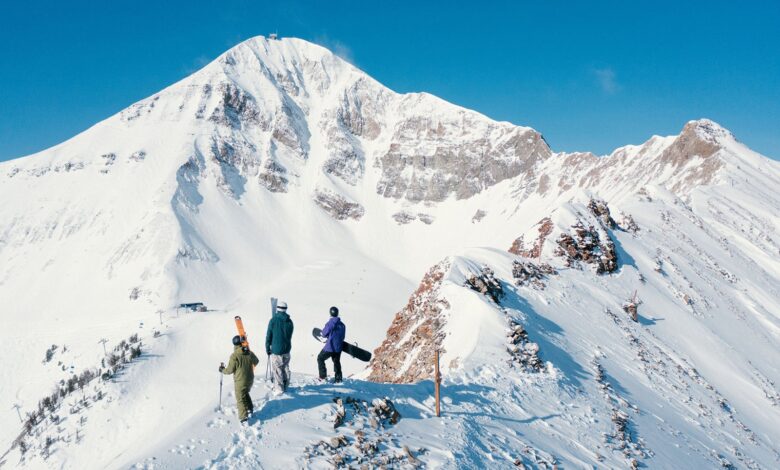Short lift lines and empty slopes: North American ski resorts where you can beat the crowds this winter

If you thought crowds were bad at ski resorts last winter, it wasn’t your imagination. According to the National Ski Areas Association, 61 million skier visits were recorded, the most in history.
The ski industry usually loves a great snowstorm, but recent years have brought about a different kind of perfect storm — overcrowding — one many resorts and travelers would prefer to live without.
Long lift lines have become viral social media sensations. Last winter, ski journalist and 20-year Steamboat resident Kelly Bastone wrote in Ski Magazine that she gave up one day and went home rather than wait two hours for the gondola. Following a February storm, she said, “I’ve never experienced lines the likes of which I found myself in.”
Cause(s) and effect
Participation in just about every kind of outdoor recreation, including skiing, spiked during the pandemic. So did the realization that you could work from any place with an internet connection. Not surprisingly, ski towns were a wildly popular choice for digital nomads.
Labor problems skyrocketed across the service industry. Ski resorts were acutely affected, given their dependence on seasonal foreign workers using H2-B and J-1 visas, which became hard or impossible to get.
The side effects were clear to disgruntled skiers. Lift attendants were scarce, mountain restaurants were closed or operated at reduced capacity, parking lot shuttles services were limited and just renting ski equipment could take hours.
But pandemic-related issues were just fuel on a fire lit years earlier when the entire lift ticket paradigm changed.
For most of history, each ski resort sold daily, multi-day or season passes, good only at that one location. But, a new breed of pass has emerged that quickly proved much more economical and versatile for snow sports enthusiasts — one that covered dozens of big-name resorts.
The passes became a double-edged sword: Choice and value are a boon to consumers, but many ski town locals blame them for a tsunami of long lines and increased strain on infrastructure.
Sign up for our daily newsletter
The two biggest passes are the Epic Pass (2.1 million sold last winter) and Ikon Pass (number sold unknown; the company doesn’t release sales numbers), joined by smaller players including Mountain Collective and Indy Pass.
So what’s a skier to do if they are looking for a little more room to spread out — and a lot less waiting around in lift lines?
Related: What’s the best ski pass this season? Comparing Epic, Ikon, Mountain Collective and Indy Pass
Fantastic resorts, fewer crowds
Key factors that contribute to crowds at a ski resort are its fame, proximity to larger urban drive markets, its size and ability to spread people out, the quality of its lift system and the supply of area hotel rooms and homes. The fewer people who can stay near a resort, the less crowded it will be.
The good news is that there are ways for you you can skip long lines while still taking advantage of the value proposition of a multi-resort pass — as almost all of these top “Beat the Crowd” picks accept one or more of those passes. This is especially helpful if you use your pass at a home mountain on weekends and then want to take a big trip outside of your region.
So here are TPG’s top ski destinations where you can switch gears and enjoy short lines and empty slopes:
Big Sky, Montana
Utah’s Park City Mountain Resort is the country’s largest ski resort. It’s extremely accessible given its proximity to Salt Lake City International Airport (SLC), a major international Delta hub, and it’s a comfortable place to stay with an abundance of ski-in, ski-out lodging and residences.
Big Sky is the nation’s second-largest ski resort, but it’s the complete opposite. There’s no major urban drive market, it’s home to a much smaller gateway airport — Bozeman Yellowstone International Airport (BZN) — and while there is a lot of development planned, it’s currently still underserved by hotel rooms.
After a decade of substantial mountain improvements, Big Sky also has arguably the nation’s most advanced lift system, with high-speed six- and eight-passenger heated chairs, a large, new high-speed tram under construction, and vast swaths of the mountain, especially the Moonlight Basin side, largely empty — even on weekends.
It boasts an astonishing average of over an acre of terrain per skier and is easily the least crowded of the nation’s highest-tier marquee destination resorts. And, it’s part of the Ikon Pass and Mountain Collective.
Banff Sunshine, Alberta
Whistler/Blackcomb, located 75 miles from Vancouver along the famed Sea to Sky Highway, is the single most popular ski resort on the continent. Its fame diverts many winter vacationers away from Ski Big 3, the trio of resorts uniquely located within stunning Banff National Park, Canada’s oldest.
Sunshine is the least well-known, despite having a wide variety of terrain, including exceptionally challenging expert skiing. It’s very large by North American standards at 3,300-acres, and a high base at 7,200-feet means reliable snow and one of Canada’s longest seasons.
The only lodging option is accessed by gondola, so most people stay in charming Banff, 8 miles away, and hop on the free shuttle bus to reach Sunshine.
Most Banff skiers, however, are drawn to even bigger Ski Big 3 sibling Lake Louise, which extends across 4,200 acres after a 480-acre bowl expansion last winter, keeping Sunshine empty. Tickets are interchangeable at both resorts, shuttles are free, and Lake Louise still remains relatively uncrowded, so you can hit it on slower weekdays and ski Sunshine on weekends or holidays.
Banff is an easy drive from Calgary International Airport (YYC), and all three Banff resorts are part of Ikon Pass and Mountain Collective.
Related: 7 ski resorts we can’t wait to visit again
Schweitzer, Idaho
It is definitely not Idaho’s most famous ski resort, but Schweitzer is the state’s largest, at nearly 3,000 skiable acres. Plus, it offers rare on-site heli-ski and cat-skiing operations.
Named the “Best Kept Secret in North America” by Ski Magazine, it’s a true hidden gem in the Panhandle, closer to the Canadian border and gateway airport of Spokane International Airport (GEG) than to Boise, Idaho’s largest city.
Because it owns its land (most ski resorts lease from the Forest Service or similar) it can do whatever it wants, and it has. Underbrush has been thinned out and practically the entire mountain has been gladed. Skiable wooded terrain between trails creates a very unusual aesthetic that results in a virtually infinite number of routes down, dispersing the already small crowds still further.
In addition, Schweitzer is not a ski town but a base village, home to just a few restaurants and limited lodging, including a couple of condo hotels and a new, upscale boutique property, Humbird Hotel.
Ikon Pass holders can ski for seven days at Schweitzer.
Sun Valley, Idaho
Sun Valley is Idaho’s most famous resort, the nation’s very first destination ski area (1936) and the inventor of the chairlift. It has a long history of Hollywood glamor, patterned on Swiss resorts such as Gstaad and St. Moritz. Yet despite its rich history and countless accolades — it was just named “Number One Ski Resort” by Ski Magazine for the third straight year — it has an equally long tradition of no lift lines.
The resort is not near any major population centers, and it has limited lodging compared to its more glamorous peer group. You won’t find flashy brand names like Four Seasons or Montage here, and the dining, shopping and apres ski scene are decidedly low-key.
The mountain owns the lone luxury hotel, Sun Valley Lodge, and swaths of the base village, channeling a frozen-in-time “Dirty Dancing” aesthetic that skews to longtime repeat visitors. As a result, the vibe is more authentic ski town than a see-and-be-seen resort.
But where Sun Valley really stands out is its beginner terrain. The resort has two mountains, and smaller Dollar Mountain is one of the very best places on Earth for novices to learn skiing or snowboarding, with extensive terrain features just for teaching and renowned instruction.
Baldy Mountain is famed for having one of the longest vertical drops in North America (3,400 feet) and plenty of expert skiing. For intermediate and advanced skiers, the mountain’s main selling point is its “constant pitch,” or long unbroken sections that don’t vary in grade and are absolutely perfect for skiers seeking to take their technique up a notch; it’s ideal for carving and practicing precise turns, one after another.
In short, if your goal is to learn to ski, introduce a family member to skiing, or become a better skier, and you don’t like crowds, Sun Valley is the answer. It also has on-site day heli-skiing.
You can ski or snowboard Sun Valley for seven days with the Ikon Pass or two days with Mountain Collective.
Eagle Point, Utah
With the best snow most skiers and snowboarders have never heard of, Eagle Point sits in Southwestern Utah, far from the resorts of Salt Lake. It also gets more white stuff than most of them: an impressive annual average of over 350 inches.
Thanks to a 9,100-foot base, it also holds that famously light, dry Utah powder well. But what really sets Eagle Point apart is that its gateway airport is Las Vegas’s Harry Reid International Airport (LAS), which, in winter, is an easy and often inexpensive flight. Since it’s a three-and-a-half-hour drive (mostly on snow-free interstate) to reach Eagle Point, that helps keeps crowds down.
So does the scant lodging, which accommodates less than 400 people. It’s a small resort at 650 acres and 40 trails, but it skis big because of all the unbroken powder and low skier numbers. It also has backcountry gates in partnership with the National Forest Service, allowing access to immense off-piste terrain.
With no town, there’s a throwback vibe to the place. Development is limited to just a main lodge with a bar, restaurant and general store, a day lodge with a cafeteria, and really not much else — well, except lots of powder and its uncrowded slopes.
The biggest drawback is that except Christmas week, the mountain is only open Friday to Monday, but the unintended result is a unique hybrid Las Vegas/ski vacation like nothing else. It’s also perfect for tacking a ski weekend onto a Sin City convention.
Eagle Point walk-up lift tickets are affordable, ranging between $50 and $75 per person, depending on the day, or you can ski the resort as an Indy Pass holder.
Powder Mountain, Utah
Powder Mountain claims to be the nation’s largest ski resort at nearly 8,500-acres, but this is debatable because that includes additional fee, cat-served terrain, which other resorts typically do not count. But regardless, it is huge — the largest of the many Salt Lake City area resorts – and among the least visited.
Powder Mountain and Snowbasin surround the increasingly hot small city of Ogden, about an hour’s drive from Salt Lake City’s airport. They are also the nation’s two largest resorts without hotels. Snowbasin is under development and will have ski-in, ski-out lodging for 2023, while Powder is sticking with its lineup of cabins, townhomes and chalets; many are brand new and quite nice, but the lodging (and dining) still remains minuscule compared to the skiing.
A dearth of lodging is just one factor that keeps Powder Mountain a crowd-free resort. Another is the Powder Country zone: 1,200 acres of in-bounds, off-piste terrain. You ski through a gate and enter a backcountry area bordered by a road, so gravity always brings you to roving buses that return you to the base. It’s included with lift tickets and there’s nothing else like it at other resorts. Powder Mountain also offers $25 single-ride, cat-skiing laps at another part of the huge property.
Finally, Powder is not on any of the multi-mountain passes, and limits its own season pass sales to 3,000. Whether you sequester at Powder or opt for the much broader offerings of Ogden and commute in (20 miles), you get a full-on big mountain experience with some of the least crowded slopes in the West.
Sugarloaf, Maine
Most major New England resorts are considerably smaller than their Western counterparts and face added pressure from an immense drive market that includes 20 million or so people in the New York metro area alone, plus Boston, Philadelphia, Portland and others.
For uncrowded options, Sugarloaf stands out. It’s not only one of the largest and best Eastern mountains but it’s also the most remote; a two-and-a-half hour drive from Portland and four hours from Boston — and that’s without traffic, a rarity.
Sugarloaf is home to the second-highest ski peak in New England (by 4 feet!), but has by far the longest vertical, at nearly 3,000 feet. It’s also the second largest by acreage but has by far the greatest number of trails (162). On top of that (literally!) it boasts the only lift-served, above-tree-line resort bowl skiing in the East.
It takes a bit of effort to get here (its motto is “Worth every mile”) but when you do, there’s a fully amenitized resort with plenty of dining, drinking and lodging options, a place that sets up well for a weeklong stay. And, you can ski as part of the Ikon Pass or Mountain Collective.
Crested Butte, Colorado
No longer a hidden gem, Crested Butte has steadily drawn the attention of avid skiers over the years, and now faces the same struggles with a lack of employees, affordable housing and displaced locals as many high-rent Western ski towns. But people love skiing in Colorado, and for good reason — and Crested Butte vies only with Telluride as the state’s least crowded big-time destination resort.
The 19th-century mining town has managed to preserve much of its small town, Old West ambiance and atmosphere, something missing in Vail, Beaver Creek, Snowmass and many other top Colorado resorts, and features mostly independent stores and restaurants. This helps keep things uncrowded, because there’s little lodging, with nary a Hyatt or Marriott in sight.
On the mountain, a new lift last winter and another two years earlier greatly increased uphill capacity out of the base area, and then things spread out quickly, with 15 lifts serving over 120 trails.
Much of Crested Butte’s appeal is for experienced skiers who want to beat the crowds. Over 60% of the terrain is rated advanced or expert, and the expert skiing and riding here is at the extreme end of the spectrum, putting Crested Butte in a league with places infamous for their challenge such as Jackson Hole, Palisades Tahoe and Snowbird.
You can ski or snowboard at Crested Butte unlimited days (and with no blackouts) as an Epic Pass holder.
Grand Targhee, Wyoming
To say Targhee is overshadowed by nearby Jackson Hole is an understatement. The latter is the world-renowned star of countless ski films, has the enviable nickname “The Big One,” the nation’s largest vertical, and famously difficult chutes and cliffs. Conversely, many skiers have never even heard of Grand Targhee.
The reality is that most skiers aren’t jumping off cliffs. Jackson is seriously lacking for novice skiers, it has become increasingly packed, and its famous tram was already notorious for lines long before the pandemic.
Targhee is farther flung, 90 minutes from the small Jackson Hole Airport (JAC) and Idaho Falls Regional Airport (IDA), and uncrowded for sure. Ski Magazine has described “lift lines that rarely allow time to unbuckle your boots.”
It also gets appreciably more snow than its Wyoming sibling — with an average of over 500 inches it holds one of the nation’s highest tallies of light, dry powder. It’s got extensive beginner and intermediate terrain, plenty of advanced (though shorter) runs, and backcountry access — truly a powder fiend’s dream.
The 2,600-plus acres — a mix of glades, bowls and trails — are almost all entirely skiable, with more actual skiing for its ample size than most competitors. It’s also home to on-site, snowcat skiing, for serious powder lovers.
Mountain Collective pass holders can ski for two days at Grand Targhee.
Planning a ski trip this winter? Read on for more tips and stories:
Sleigh rides and snowball fights: Top 8 ski resorts for people who don’t like to ski
8 affordable ski resorts in the US worth the trip
From hidden gems to big names: Here are 11 of California’s best ski resorts
15 of our favorite ski-friendly resort hotels you can book on points
Why the best big family vacation may be skiing




